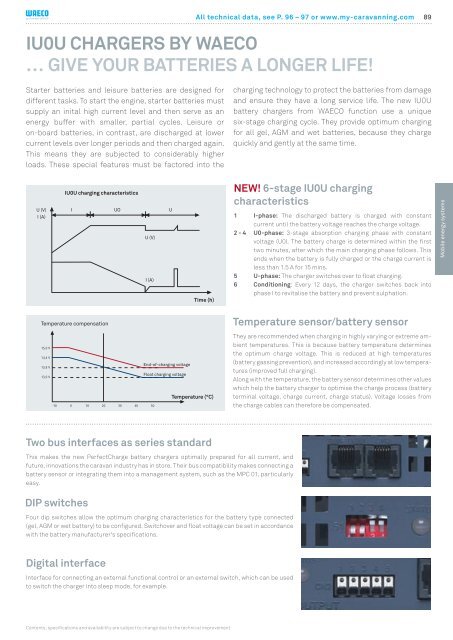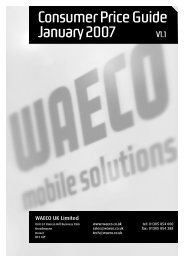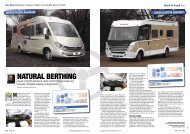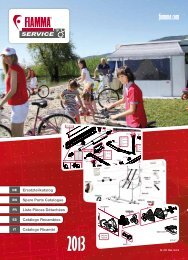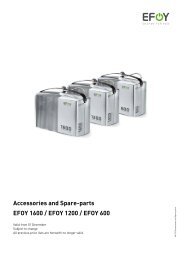NEW - Cooltech Leisure
NEW - Cooltech Leisure
NEW - Cooltech Leisure
You also want an ePaper? Increase the reach of your titles
YUMPU automatically turns print PDFs into web optimized ePapers that Google loves.
All technical data, see P. 96 – 97 or www.my-caravanning.com 89<br />
IU0U chargers by WAECO<br />
… give your batteries a longer life!<br />
Starter batteries and leisure batteries are designed for<br />
different tasks. To start the engine, starter batteries must<br />
supply an inital high current level and then serve as an<br />
energy buffer with smaller, partial cycles. <strong>Leisure</strong> or<br />
on-board batteries, in contrast, are discharged at lower<br />
current levels over longer periods and then charged again.<br />
This means they are subjected to considerably higher<br />
loads. These special features must be factored into the<br />
charging technology to protect the batteries from damage<br />
and ensure they have a long service life. The new IU0U<br />
battery chargers from WAECO function use a unique<br />
six-stage charging cycle. They provide optimum charging<br />
for all gel, AGM and wet batteries, because they charge<br />
quickly and gently at the same time.<br />
U (V)<br />
I (A)<br />
IU0U IUOU-Ladecharakteristik<br />
charging characteristics<br />
I UO U<br />
U (V)<br />
I (A)<br />
Time (h)<br />
Zeit (h)<br />
<strong>NEW</strong>! 6-stage IU0U charging<br />
characteristics<br />
1 I-phase: The discharged battery is charged with constant<br />
current until the battery voltage reaches the charge voltage.<br />
2 - 4 U0-phase: 3-stage absorption charging phase with constant<br />
voltage (U0). The battery charge is determined within the first<br />
two minutes, after which the main charging phase follows. This<br />
ends when the battery is fully charged or the charge current is<br />
less than 1.5 A for 15 mins.<br />
5 U-phase: The charger switches over to float charging.<br />
6 Conditioning: Every 12 days, the charger switches back into<br />
phase I to revitalise the battery and prevent sulphation.<br />
Mobile energy systems<br />
Temperature compensation<br />
15,0 V<br />
14,4 V<br />
13,8 V<br />
13,0 V<br />
-10<br />
0 10 20 30 40<br />
Ladeschlussspannung<br />
End-of-charging voltage<br />
Erhaltungsladespannung<br />
Float charging voltage<br />
50<br />
Temperature (°C)<br />
Temperature sensor/battery sensor<br />
They are recommended when charging in highly varying or extreme ambient<br />
temperatures. This is because battery temperature determines<br />
the optimum charge voltage. This is reduced at high temperatures<br />
(battery gassing prevention), and increased accordingly at low temperatures<br />
(improved full charging).<br />
Along with the temperature, the battery sensor determines other values<br />
which help the battery charger to optimise the charge process (battery<br />
terminal voltage, charge current, charge status). Voltage losses from<br />
the charge cables can therefore be compensated.<br />
Two bus interfaces as series standard<br />
This makes the new PerfectCharge battery chargers optimally prepared for all current, and<br />
future, innovations the caravan industry has in store. Their bus compatibility makes connecting a<br />
battery sensor or integrating them into a management system, such as the MPC 01, particularly<br />
easy.<br />
DIP switches<br />
Four dip switches allow the optimum charging characteristics for the battery type connected<br />
(gel, AGM or wet battery) to be configured. Switchover and float voltage can be set in accordance<br />
with the battery manufacturer's specifications.<br />
Digital interface<br />
Interface for connecting an external functional control or an external switch, which can be used<br />
to switch the charger into sleep mode, for example.<br />
Contents, specifications and availability are subject to change due to the technical improvement.


